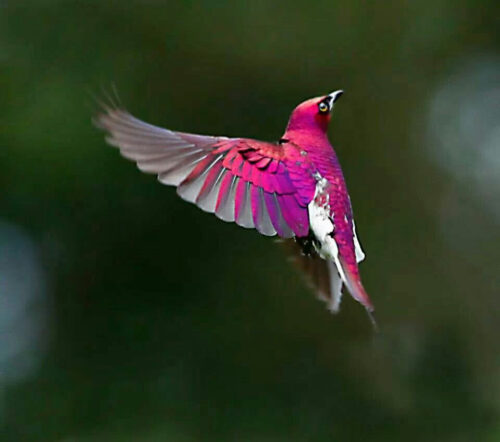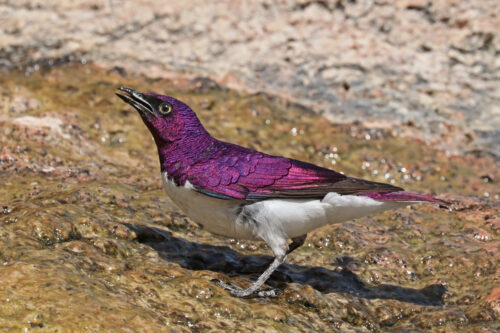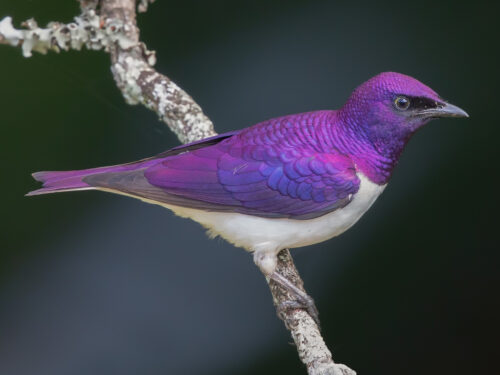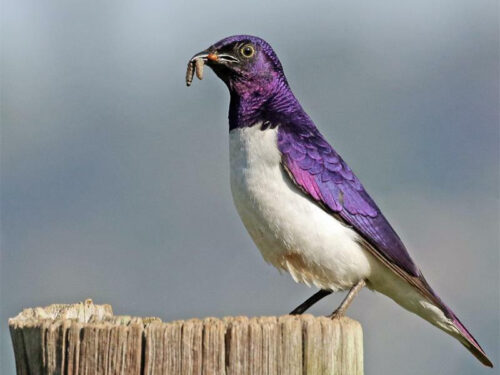
The violet-backed starling, a remarkable bird species found in sub-Saharan Africa, showcases nature’s vibrant palette with its stunning plumage.
With its deep violet-colored back feathers, this medium-sized bird captivates observers with its beauty and distinct characteristics.
In this article, we delve into the intriguing features of the violet-backed starling, its social behavior, diet, conservation concerns, and the importance of preserving its habitats for future generations.

- Aesthetic Marvel: The Vibrant Violet-Backed Plumage
The violet-backed starling boasts a mesmerizing appearance, highlighted by its rich violet-colored back feathers.
This iridescent sheen sets it apart from other bird species and makes it a sight to behold. With a dark brown body, pale belly, and chest, the vibrant contrast of colors showcases nature’s artistic brilliance.
Observing this bird in its natural habitat offers a unique opportunity to witness the faithful expression of color and beauty found in the avian world.
- Sociable Songsters: The Vocal and Social Nature of Violet-Backed Starlings
Violet-backed starlings are highly social creatures known for their distinctive calls.

Throughout the day, their melodious voices fill the air, creating a symphony of sound. These birds often travel in flocks, forming communities of up to 50 individuals. During the breeding season, male starlings proudly display their colorful plumage and sing to attract potential mates. The social behavior and vocal nature of violet-backed starlings add to the allure of observing these captivating creatures.
- Dietary Preferences: Exploring the Frugivorous Feeding Habits
Feeding primarily on fruits, berries, and seeds, the violet-backed starling plays a crucial role in seed dispersal and plant regeneration.
Their frugivorous diet contributes to the maintenance of ecological balance in their habitats.
Additionally, they consume insects and other small invertebrates, showcasing their adaptability and versatility in foraging.
Understanding the dietary preferences of these birds helps appreciate their ecological significance and their interconnectedness with their environment.

- Conservation Concerns: Protecting Habitats and Raising Awareness
While the violet-backed starling is not currently considered a threatened species, habitat loss and fragmentation pose potential threats to their populations.
Human activities, including deforestation and land development, impact their natural habitats.
Conservation efforts are underway to safeguard their habitats and raise awareness about the importance of preserving these birds and their ecosystems.
Supporting these initiatives is crucial for the long-term survival of the violet-backed starling and the biodiversity it represents.
The violet-backed starling stands as a remarkable testament to the vibrant beauty found in nature.
With its striking violet plumage, social behavior, and distinctive calls, it enthralls bird enthusiasts and nature lovers alike.
However, it is vital to recognize the challenges these birds face due to habitat loss and fragmentation.
By supporting conservation efforts and raising awareness, we can ensure the preservation of the violet-backed starling’s populations and habitats.

Let us cherish and protect these captivating creatures, allowing future generations to admire their expressive plumage and contribute to the thriving biodiversity of our planet.
Video:






